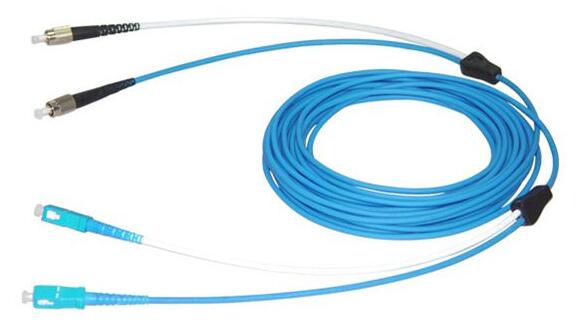Feb. 24, 2022
Every fiber optic technician has heard of the terms field polishing and factory polishing
What's the difference? Why is it so important which option you choose for your application? When you compare field terminated cables to plug-and-play factory terminated solutions, many factors differ greatly.
Termination is just a fancy way of saying that you are attaching a connector to a certain type of fiber. It can be single-mode or multimode fiber. The mode of the fiber only determines what kind of connector you need, not the termination you have to do. There are advantages and disadvantages to each method when choosing the method to use for your application. There are many factors that can affect your reasons for choosing a particular termination method. If you are using MTP or MPO connectors it is probably wise to choose factory termination because these connectors are complex and require a level of expertise. If you are using more common connector styles in your project, such as LC, SC, ST, or FC, you can use a field termination method rather than outsourcing to a cable assembly plant for factory termination.

Types of Factory Fiber Termination
The following options are available for factory termination.
►Custom manufactured cable assemblies or stock patch cords
►Fiber pigtails
►Splices on connectors
Custom fabricated cable assemblies and stock patch cords
Factory terminated joints are typically assembled using traditional epoxy and polished assembly methods. Cable assemblies must be ordered in the length required to complete the fiber run. Factory polished assemblies typically offer the best performance, and they have more stringent quality standards than field terminations, making them the best solution for applications requiring low loss and high performance. Most factory terminated assemblies come with the manufacturer's test results, so you know you are getting the best quality and excellent performance from the assemblies you buy.
of patch cords Cable assembly plants can be customized to meet any special requirements your application may require. This makes them ideal for customers who need specific performance standards, special fibers, or custom color jacketing on their patch cords. These solutions often reduce the time required to install them because they are ready to be plugged in and ready to work when they arrive. The technician does not have to do anything with the jumper, other than remove the ferrule protection cap and clean the connector end face. Very little technical knowledge is required; the technician simply plugs the assembly into the correct port and terminal block on the device.
One possible disadvantage of factory-polished terminals is that they do take time to manufacture and delivery times can be long, depending on the manufacturer. In addition, jumpers typically cost more because of the custom labor required to build the individual components to order. You should also consider network downtime when making your decision. If you are in a situation that requires a quick response, such as a damaged connector that needs immediate attention to bring the network back online, you may not have time to wait for a custom assembly.
Fiber Pigtail
The pigtail that will be spliced into an existing fiber is also a factory polished connector, but it is only terminated on one side of the fiber while the other side is exposed for fusion splicing. Pigtails are a good and affordable option for technicians who have experience with fiber splicing and own a fusion splicer. Pigtails are typically available in stock lengths and can be supplied "off the shelf" in the most widely used connector styles. Since the process involves splicing and labor, it does add some additional work time, but not as much as the time required to install epoxy and polish the connectors.
Splicing on Connectors
Splices on connectors are also a factory polished option. They can be applied in the field by using a fusion splicer and some consumables. They are available in a variety of styles, including singlemode and multimode fiber types. soc can be installed in the field quickly and easily, and each connector is affordable. They do require a fusion splicer and some additional tools to terminate, as well as some knowledge of the process of terminating the SOC (splice on connector). They are disposable connectors. Once they are terminated, they cannot be reused.
Field termination types
The following options are available for field termination.
► Fiber pigtail
► Splice connectors
► Mechanical connectors
(We have discussed pigtails and connectors on connectors above. These factory polished options are most often connected to the fiber in the field, so they also fall into the field termination category.)
Field Termination
Field termination can also be accomplished by using mechanical connectors. In this case, the fiber is cut to a specific length and the field fiber is mated to a fiber splice inside a factory-polished mechanical connector with a refractive index matching gel. These connectors allow fast and reliable termination in the field. They are available in a variety of configurations for multimode and singlemode applications.
Depending on the connector manufacturer, special tools are sometimes required to terminate mechanical connectors, and these can be somewhat expensive. However, once purchased, they have a long service life and only need to be replaced with consumables.
Mechanical Connectors
Mechanical connectors are fairly easy to terminate and field technicians can quickly learn the process, but they do have drawbacks. These connectors have higher reflectivity and loss than their SOC or pigtail counterparts. Therefore, if your job requires optimal performance, these connectors may not be the best solution.
No MTP/MPO Mechanical Connectors
There are no MTP/MPO mechanical connectors on the market today. The most likely reason is that MTP/MPO connectors have three recognized industry standard polarities. They are referred to as Type A, Type B, and Type C. Type A is also referred to as straight-through. In this polarity, fiber 1 is located in position 1 of the two MTP/MPO connectors in the cable assembly. the second polarity, Type B, is called reversed. This means that fiber 1 is located in the first position of one connector and in the twelfth position of the second connector. The last commonly accepted polarity, Type C, is called a flipped pair. In this configuration, fiber 1 is in the first position in one connector of the assembly and in the second position in the other connector. Fiber 3 is in the third position in the first connector, the fourth position in the second connector, and so on.
Whether you choose a field solution or a factory terminated solution, each option has advantages and disadvantages as described in the paragraphs above. Hopefully, some of the information here will help you choose the best of these solutions for your application.















